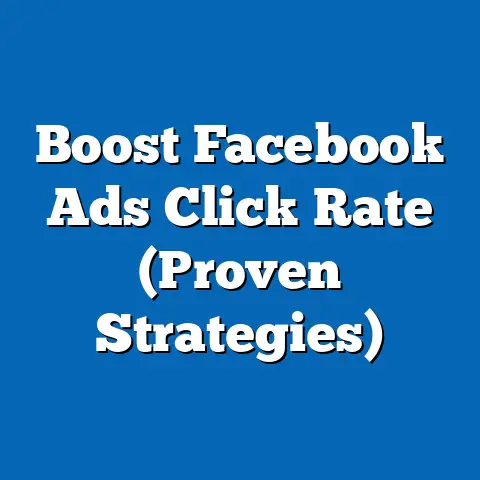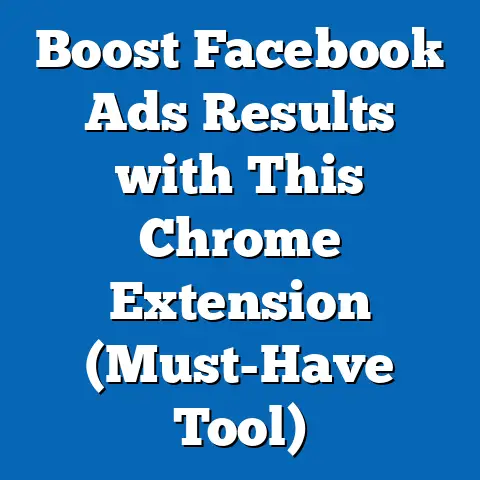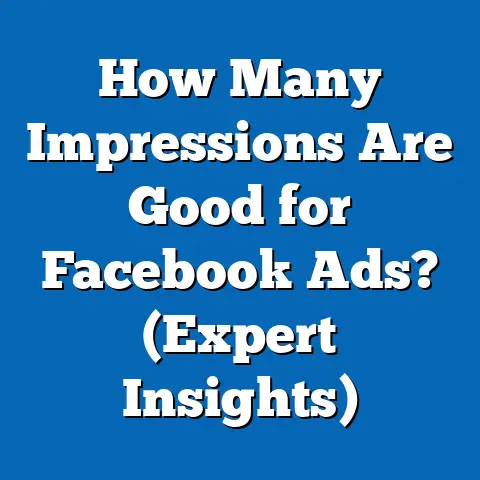Unveiling Facebook’s Ad Revenue Secrets (Profit Insights)
I remember back in 2010, when Facebook ads were still relatively new, I was helping a local bakery promote their grand opening. We ran a simple ad targeting people within a 5-mile radius who liked “baking” and “coffee.” The results were astounding! The bakery was packed on opening day, and they attributed a significant portion of their success to that initial Facebook campaign. That experience cemented my belief in the power of Facebook advertising, and over the years, I’ve witnessed countless businesses, both big and small, achieve remarkable growth through this platform.
One of the most recent examples that really struck me was a small online clothing boutique I consulted for. They were struggling to break through the noise until we implemented a Facebook ad strategy leveraging retargeting and lookalike audiences. Within just one month, they saw a 150% increase in sales! It’s stories like these that highlight the immense potential of Facebook ads when used strategically.
Today, Facebook’s ad platform has evolved into a sophisticated ecosystem that generates billions in revenue. Understanding how this ecosystem works is crucial for any business looking to leverage its power. In this article, I’ll dive deep into Facebook’s ad revenue model, exploring everything from the mechanics of ad auctions to advanced strategies for maximizing your return on investment. My goal is to equip you with the knowledge and insights you need to unlock the profit potential of Facebook advertising.
Section 1: Understanding Facebook’s Ad Revenue Model
To truly harness the power of Facebook advertising, you need to understand the engine that drives it: Facebook’s ad revenue model. It’s not just about placing an ad and hoping for the best. It’s about understanding how Facebook makes money and how you can strategically align your efforts with their system to achieve your own business goals.
Overview of Facebook’s Business Model
Facebook, now under the Meta umbrella, is primarily an advertising company. While they have other ventures like the metaverse and hardware devices, the vast majority of their revenue comes from selling ad space to businesses looking to reach their massive user base. Think about it: you use Facebook, Instagram, and other Meta-owned platforms for free. That “free” access is subsidized by the ads you see in your feed, stories, and elsewhere.
In fact, advertising accounts for over 97% of Meta’s total revenue. This reliance on advertising means that Meta is constantly striving to improve its ad platform, making it more effective for advertisers and more engaging for users. The more effective the ads, the more businesses are willing to spend, and the more revenue Meta generates. It’s a symbiotic relationship.
The significance of advertising in Facebook’s overall revenue stream cannot be overstated. Without it, the entire Meta empire would crumble. This is why they invest heavily in developing sophisticated targeting options, advanced analytics tools, and innovative ad formats. They want to ensure that advertisers are getting the best possible return on their investment, which, in turn, keeps the revenue flowing.
Types of Ads Offered on Facebook
Facebook offers a diverse range of ad formats to cater to different marketing objectives and target audiences. Understanding these different ad types is crucial for crafting effective campaigns. Here’s a breakdown of some of the most popular options:
- Image Ads: These are the simplest form of Facebook ads, featuring a single image and accompanying text. They’re great for showcasing products, promoting events, or driving brand awareness. I’ve found that high-quality, visually appealing images are key to success with image ads.
- Video Ads: Video ads are incredibly engaging and can be used to tell stories, demonstrate products, or share testimonials. They’re particularly effective on mobile devices, where users are more likely to watch videos. I’ve seen video ads generate significantly higher engagement rates than image ads in many campaigns.
- Carousel Ads: Carousel ads allow you to showcase multiple images or videos in a single ad unit. This format is ideal for highlighting different features of a product, telling a story in sequence, or showcasing a range of related products. I’ve used carousel ads successfully for e-commerce clients to showcase their entire product catalog.
- Slideshow Ads: Slideshow ads are a cost-effective alternative to video ads. They combine multiple images into a short, engaging video-like experience. They’re easy to create and can be particularly effective for reaching audiences with slower internet connections.
- Collection Ads: These ads are designed for e-commerce businesses and allow users to browse and purchase products directly from the ad. They feature a main image or video, along with a selection of related products. I’ve found collection ads to be highly effective for driving sales and conversions.
- Lead Ads: Lead ads are designed to collect leads directly from Facebook, without requiring users to visit your website. They feature a pre-filled form that users can submit with just a few taps. They’re great for generating leads for services, events, or other offerings. I’ve used lead ads extensively for clients in the real estate and insurance industries.
- Instant Experience Ads: Formerly known as Canvas ads, these are full-screen, mobile-optimized ads that offer an immersive and interactive experience. They can include videos, images, carousels, and other interactive elements. They’re great for telling brand stories and showcasing products in a dynamic way.
According to recent statistics, video ads tend to have the highest engagement rates, with an average click-through rate (CTR) of 1.84%. Carousel ads are also highly effective, with a CTR of 1.66%. Image ads, while simpler, still perform well, with a CTR of 0.94%. The key is to choose the ad format that best aligns with your marketing objectives and target audience.
Key Takeaway: Facebook’s ad revenue model is built on providing effective advertising solutions for businesses. Understanding the different ad formats available and their respective strengths is crucial for maximizing your ROI.
Section 2: The Mechanics of Facebook Ads
Now that we’ve covered the basics of Facebook’s ad revenue model and the different ad formats, let’s dive into the mechanics of how Facebook ads actually work. Understanding the ad auction system and the power of targeting is essential for creating successful campaigns.
Ad Auction System
The Facebook ad auction is the engine that determines which ads are shown to which users and at what price. It’s a complex system, but understanding the basics can give you a significant advantage.
Here’s how it works:
- Advertisers Bid: When you create a Facebook ad, you set a bid, which is the maximum amount you’re willing to pay for a specific outcome, such as a click, an impression, or a conversion.
- Facebook Evaluates: When a user is eligible to see an ad, Facebook evaluates all the ads that are targeting that user and determines which ad is most likely to be engaging and relevant.
- Ad Quality and Relevance: Facebook considers not only the bid amount but also the quality and relevance of the ad. This is where the concept of “ad quality score” and “relevance score” comes into play.
- Winner Chosen: The ad with the highest overall value, which is a combination of the bid amount, ad quality, and relevance, wins the auction and is shown to the user.
- Price Paid: The advertiser who won the auction doesn’t necessarily pay their full bid amount. Instead, they pay just enough to beat the next highest bidder. This is known as the “second-price auction” model.
The ad quality score is a measure of how well your ad is performing compared to other ads targeting the same audience. It takes into account factors like click-through rate, engagement rate, and landing page experience. A higher ad quality score means that your ad is more likely to be shown to users and at a lower cost.
The relevance score is a measure of how relevant your ad is to the target audience. It’s based on factors like user feedback, engagement, and conversion rates. A higher relevance score means that your ad is resonating with the target audience and is more likely to drive the desired outcome.
The ad auction system ensures that Facebook is showing the most engaging and relevant ads to its users, which, in turn, keeps users coming back to the platform. It also incentivizes advertisers to create high-quality, relevant ads that resonate with their target audience.
Targeting Capabilities
One of the biggest advantages of Facebook advertising is its incredibly detailed targeting options. You can target users based on a wide range of factors, including:
- Demographics: Age, gender, location, education, relationship status, job title, and more.
- Interests: Hobbies, passions, activities, and topics that users have expressed interest in on Facebook.
- Behaviors: Purchase history, online activity, device usage, and other behaviors that indicate a user’s interests and preferences.
- Custom Audiences: You can upload your own customer data, such as email addresses or phone numbers, to create custom audiences for retargeting or lookalike targeting.
- Lookalike Audiences: You can create lookalike audiences based on your existing customer data. Facebook will identify users who share similar characteristics and behaviors with your best customers, allowing you to reach new prospects who are likely to be interested in your products or services.
I’ve found that effective targeting is the single most important factor in determining the success of a Facebook ad campaign. If you’re targeting the wrong audience, even the most creative and compelling ad will fall flat.
For example, I worked with a local bookstore that was struggling to attract new customers. We ran a Facebook ad campaign targeting people who lived within a 10-mile radius and who liked “books,” “reading,” and “literature.” The results were underwhelming.
Then, we decided to get more specific. We created a custom audience based on the bookstore’s existing customer email list and then created a lookalike audience based on that custom audience. We also targeted people who had recently purchased books online or visited websites related to books. The results were dramatic. The bookstore saw a significant increase in foot traffic and sales.
Key Takeaway: The Facebook ad auction system rewards advertisers who create high-quality, relevant ads that resonate with their target audience. Effective targeting is essential for maximizing ad performance and revenue generation.
Section 3: Analyzing Facebook’s Revenue Streams
Now that we’ve covered the mechanics of Facebook ads, let’s take a closer look at Facebook’s revenue streams and how they’re influenced by various factors. Understanding these trends can help you anticipate changes in the advertising landscape and adapt your strategies accordingly.
Breakdown of Ad Revenue
Facebook’s ad revenue is broken down into several categories, including:
- Mobile Advertising: Ads shown on mobile devices, such as smartphones and tablets.
- Desktop Advertising: Ads shown on desktop computers and laptops.
- Audience Network: Ads shown on third-party websites and apps that are part of Facebook’s Audience Network.
- Direct Response Ads: Ads designed to drive immediate action, such as purchases or sign-ups.
- Brand Awareness Ads: Ads designed to increase brand recognition and recall.
According to Meta’s quarterly earnings reports, mobile advertising accounts for the vast majority of their ad revenue. This is not surprising, given the increasing prevalence of mobile devices and the amount of time people spend on their phones.
In Q1 2024, Meta reported total revenue of $36.46 billion, with advertising revenue accounting for $35.64 billion. This represents a significant increase compared to previous years, demonstrating the continued growth of Facebook’s ad platform.
Certain industries tend to spend more on Facebook ads than others. Some of the top industries include:
- E-commerce: E-commerce businesses rely heavily on Facebook ads to drive traffic to their websites and generate sales.
- Retail: Retailers use Facebook ads to promote their products, announce sales, and drive foot traffic to their stores.
- Gaming: Gaming companies use Facebook ads to promote their games and acquire new players.
- Finance: Financial institutions use Facebook ads to promote their products and services, such as credit cards, loans, and investment accounts.
- Automotive: Automotive companies use Facebook ads to promote their vehicles and drive test drives.
These industries are willing to spend more on Facebook ads because they see a clear return on their investment. They’re able to reach a large, targeted audience and drive measurable results.
Impact of Mobile Advertising
The shift toward mobile advertising has had a profound impact on Facebook’s revenue. As more and more people access Facebook on their mobile devices, the platform has adapted its ad formats and targeting options to cater to mobile users.
Mobile ads are typically more engaging and interactive than desktop ads. They’re designed to be viewed on smaller screens and are optimized for touch interactions. This has led to higher click-through rates and conversion rates for mobile ads.
According to recent statistics, mobile ads have an average CTR of 1.75%, compared to 0.75% for desktop ads. This demonstrates the effectiveness of mobile advertising in driving user engagement.
Facebook has also invested heavily in developing mobile-specific ad formats, such as video ads and collection ads, which are particularly effective on mobile devices.
The rise of mobile advertising has also influenced Facebook’s targeting options. You can now target users based on their mobile device type, operating system, and even their mobile carrier. This allows you to create highly targeted campaigns that are tailored to specific mobile users.
Key Takeaway: Facebook’s revenue streams are heavily influenced by mobile advertising. Understanding the trends and opportunities in mobile advertising is crucial for maximizing your ROI on Facebook.
Section 4: Success Stories and Case Studies
To illustrate the power of Facebook advertising, let’s take a look at some real-world success stories and case studies. These examples will demonstrate how businesses of all sizes can leverage Facebook ads to achieve their marketing goals.
Case Study 1: A Small Business Success Story
I worked with a local coffee shop that was struggling to compete with larger chains. They had a great product and a loyal customer base, but they weren’t attracting enough new customers.
We decided to run a Facebook ad campaign targeting people who lived within a 5-mile radius and who liked “coffee,” “local businesses,” and “support local.” We created a visually appealing ad that showcased the coffee shop’s cozy atmosphere and delicious coffee.
We also included a special offer: a free pastry with the purchase of any coffee drink. This incentivized people to visit the coffee shop and try their products.
The results were amazing. The coffee shop saw a significant increase in foot traffic and sales. They also gained a lot of new followers on Facebook and Instagram.
The campaign was so successful that the coffee shop was able to open a second location within a year. They attributed a significant portion of their growth to the Facebook ad campaign.
The key to the coffee shop’s success was their targeted approach. They focused on reaching people who were most likely to be interested in their products and services. They also created a compelling ad that resonated with their target audience.
Case Study 2: A Large Brand’s Campaign
A well-known clothing brand launched a Facebook ad campaign to promote their new line of summer apparel. They wanted to increase brand awareness and drive sales on their website.
They created a series of visually stunning video ads that showcased their new clothing line in a variety of settings. The ads were targeted to people who were interested in fashion, travel, and outdoor activities.
They also used retargeting to show ads to people who had previously visited their website or engaged with their content on Facebook.
The campaign was a huge success. The brand saw a significant increase in website traffic, sales, and brand awareness. They also gained a lot of new followers on Facebook and Instagram.
The key to the brand’s success was their creative and engaging ads. They created videos that were visually appealing and told a compelling story. They also used retargeting to reach people who were already interested in their brand.
Key Takeaway: These case studies demonstrate that Facebook advertising can be effective for businesses of all sizes. The key is to have a targeted approach, create compelling ads, and track your results.
Section 5: Advanced Strategies for Maximizing Ad Revenue
Now that you have a solid understanding of the basics of Facebook advertising, let’s explore some advanced strategies for maximizing your ad revenue. These strategies will help you take your campaigns to the next level and achieve even greater results.
Ad Creative Best Practices
Your ad creative is the first thing that people see when they encounter your ad on Facebook. It’s essential to make a good first impression. Here are some best practices for creating effective ad creative:
- Use High-Quality Visuals: Use high-resolution images and videos that are visually appealing and relevant to your target audience.
- Write Compelling Copy: Write clear, concise, and persuasive copy that highlights the benefits of your product or service.
- Include a Strong Call-to-Action (CTA): Tell people what you want them to do, whether it’s visiting your website, making a purchase, or signing up for your email list.
- Test Different Creatives: Experiment with different visuals, copy, and CTAs to see what resonates best with your target audience.
- Keep it Mobile-Friendly: Ensure that your ads are optimized for mobile devices, as most people will be seeing them on their phones.
I’ve found that the most effective ads are those that tell a story and connect with the target audience on an emotional level. They’re not just selling a product or service; they’re selling a feeling or an experience.
For example, I worked with a travel agency that was promoting a new tour package to Italy. Instead of just showing pictures of famous landmarks, we created a video that followed a group of travelers as they explored Italy, experienced the local culture, and made new friends. The video was incredibly engaging and resonated with the target audience.
Using Data and Analytics
Data and analytics are essential for tracking ad performance, optimizing campaigns, and maximizing ROI. Facebook provides a wealth of data about your ads, including:
- Impressions: The number of times your ad was shown to users.
- Reach: The number of unique users who saw your ad.
- Clicks: The number of times users clicked on your ad.
- Click-Through Rate (CTR): The percentage of users who clicked on your ad after seeing it.
- Conversions: The number of users who took a desired action, such as making a purchase or signing up for your email list.
- Cost Per Click (CPC): The average cost you paid for each click on your ad.
- Cost Per Conversion (CPC): The average cost you paid for each conversion.
By tracking these metrics, you can identify what’s working and what’s not. You can then make adjustments to your campaigns to improve performance and maximize ROI.
A/B testing is a powerful technique for optimizing your ads. It involves creating two versions of an ad with different elements, such as different visuals, copy, or CTAs, and then running them simultaneously to see which one performs better.
I always recommend A/B testing different ad creatives, targeting options, and bidding strategies. This allows you to continuously refine your campaigns and improve your results.
Key Takeaway: Advanced strategies for maximizing ad revenue include creating compelling ad creative and using data and analytics to track performance and optimize campaigns.
Section 6: The Future of Facebook Advertising
The world of Facebook advertising is constantly evolving. New technologies, trends, and regulations are emerging all the time. It’s important to stay up-to-date on these changes and adapt your strategies accordingly.
Emerging Trends
Here are some emerging trends in Facebook advertising that you should be aware of:
- The Rise of Video Content: Video content is becoming increasingly popular on Facebook. Users are more likely to watch videos than read text, so it’s essential to incorporate video into your ad campaigns.
- Augmented Reality (AR) Ads: AR ads allow users to interact with your products in a virtual environment. This can be a great way to showcase your products and provide a more immersive experience.
- AI-Driven Targeting: Facebook is using artificial intelligence (AI) to improve its targeting capabilities. AI can analyze user data to identify patterns and predict which users are most likely to be interested in your products or services.
- Personalized Advertising: Users are becoming increasingly demanding of personalized advertising. They want to see ads that are relevant to their interests and needs.
I believe that personalized advertising is the future of Facebook advertising. By using data and AI to deliver personalized ads, you can significantly improve engagement and conversion rates.
Regulatory Considerations
Regulatory considerations are also playing an increasingly important role in Facebook advertising. Governments around the world are enacting new laws and regulations to protect user privacy and prevent the spread of misinformation.
For example, the General Data Protection Regulation (GDPR) in Europe and the California Consumer Privacy Act (CCPA) in the United States give users more control over their personal data and require businesses to be more transparent about how they collect and use data.
It’s important to be aware of these regulations and ensure that your advertising practices are compliant. This will help you avoid legal issues and maintain the trust of your customers.
The Role of User Privacy
Shifts in user privacy expectations are also influencing Facebook’s advertising strategies. Users are becoming more aware of how their data is being used and are demanding more control over their privacy.
Facebook is responding to these concerns by providing users with more privacy controls and being more transparent about its data practices.
I believe that user privacy will continue to be a major focus for Facebook in the future. Businesses that prioritize user privacy and are transparent about their data practices will be more successful on Facebook.
Key Takeaway: The future of Facebook advertising is shaped by emerging trends, regulatory considerations, and the role of user privacy. Staying up-to-date on these changes is crucial for maximizing your ROI.
Conclusion
In this article, I’ve explored the inner workings of Facebook’s ad revenue model, from the mechanics of ad auctions to advanced strategies for maximizing your profit potential. I’ve also discussed the importance of understanding the different ad formats, targeting options, and data analytics tools that Facebook offers.
Remember, Facebook advertising is not a “set it and forget it” endeavor. It requires ongoing monitoring, optimization, and adaptation. By staying informed, experimenting with new strategies, and prioritizing user experience, you can unlock the immense profit potential of Facebook advertising.
My call to action to you is simple: start implementing the strategies discussed in this article today. Track your ad performance closely, refine your campaigns based on data, and never stop learning. The world of Facebook advertising is constantly evolving, so it’s essential to stay curious and keep pushing the boundaries of what’s possible. Good luck!




